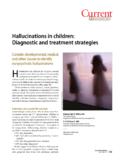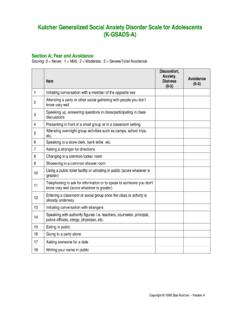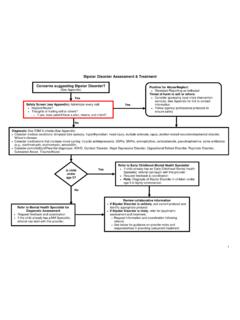Transcription of The Child Bipolar Questionnaire (CBQ) A Screening ...
1 The Child Bipolar Questionnaire (CBQ)A Screening Instrument for Juvenile-onsetBipolar DisorderDemitri F. Papolos, Melissa Cockerham, and John Hennon, order to address the significant gap in available psychiatric rating scaleinstruments designed to assess juvenile-onset Bipolar disorder symptoms,the Juvenile Bipolar Research Foundation (JBRF) has supported thedevelopment of an assessment instrument for this purpose. This scale,called the Child Bipolar Questionnaire (CBQ), is a 65-item behavioralassessment tool. Preliminary data indicate that the CBQ has adequate-to-excellent test-retest and inter-rater reliability characteristics; that it isinternally consistent.
2 The instrument is written in simple English (estimatedreading grade level = 8), and it may be used with either a parent/parentsubstitute or a clinician as the assessor. Some preliminary work examiningutility and reliability of the instrument when self-administered is quitepromising (data to be published). A Spanish-language version is alone or in combination with other psychiatric rating scales, the CBQmay prove to be an effective Screening tool for early-onset Bipolar the Internet-based data collection system of the JBRF, ), we have assembled data germane to this JBRF website data collection system has been fully operative since early2003 and CBQ data, and other diagnostically-useful information have nowbeen assembled on several thousand children /adolescents.
3 For a substantialfraction of the children and adolescents for whom website accounts at theJBRF website have been established, the parents/guardians report that therehas been a diagnosis of Bipolar disorder previously assigned by a physician(usually pediatrician or Child psychiatrist) or other health availability of JBRF s large and growing database with information oftestable reliability on both psychiatric rating scale data and prior/currentbipolar disorder diagnostic status provides a potentially rich opportunity forthe development of a Screening algorithm designed to identifychildren/adolescents with a strong diathesis for, or early onset of, bipolardisorder.
4 Accordingly, we assembled CBQ data, and related parent-providedhistory and current symptoms information via the JBRF s Internet-based dataacquisition Rating Scale Characteristics. The CBQ item data are obtainedas Likert scale data, with response range 1-4. For the purposes of theanalyses, we dichotomized these responses, with 1-2 recoded as zero and 3-4recoded as 1. The CBQ instrument has an important subscale called the CBQCore Bipolar Symptoms Subscale, comprising 35 of the 65 CBQ of a probable diagnosis of childhood-onset Bipolar disorder isbased on positive endorsement of >40/65 general items at frequencies > 2,or alternatively at least 20/33 core syndromal symptoms (see below).
5 ResultsThere were 827 subjects for whom both Bipolar diagnostic and CBQ datawere obtained via the JBRF internet-based system. For 619 ( ) ofthese subjects, it was reported that a diagnosis of Bipolar disorder hadformally been assigned at some prior time by a clinician (pediatrician,psychiatrist, or other clinician). Included in this group were 290 girls( ) and 537 boys; average age was years (range 20).Receiver operating characteristic (ROC) analysis predicting BPD diagnosticstatus from CBQ total score while adjusting for age and sex, and using a75% prediction probability as a binary cutoff-point revealed effectivepredictive capability for the CBQ instrument.
6 With this cutoff, the positivepredictive value of the CBQ was , with sensitivity = andspecificity = the CBQ items with the strongest correlations with BPD diagnosis areseveral that have obvious face validity. For example, the three CBQ itemsmost strongly correlated with Bipolar diagnostic status are: Item 62 Hasacknowledged experiencing hallucinations, Item 26 Has many ideas at once, and Item 31 Displays abrupt, rapid mood swings. All of these have oddsratios exceeding D, Cockerham M, Hennen, J. 2004. The Child Bipolar Questionnaire :Preliminary reliability and validity data, submitted for publication, journal unspecifiedin compliance with journal rules for The Development of The Child Bipolar Questionnaire V.
7 A DiagnosticScreening Inventory for Juvenile-onset Bipolar Disorder. Papolos,, Tresker, Bipolar Disorder Conference March, 2003, Washington, Papolos, , & Papolos, The Bipolar Child : The Definitive and ReassuringGuide to One of Childhood's Most Misunderstood disorders . Broadway Books, ,December, Bipolar Child Questionnaire Version Syndromal Symptoms4) is hyperactive and easily excited in the PM5) has difficulty settling at night 6) had difficulty getting to sleep10) craves sweet-tasting foods24) is easily excitable 25) has periods of high, frenetic energy and motor activation 26) has many ideas at once27) interrupts or intrudes on others28) has periods of excessive and rapid speech29) has exaggerated ideas about self or abilities30) tells tall tales.
8 Embellishes or exaggerates31) displays abrupt, rapid mood swings32) has irritable mood states33) has elated or silly, goofy, giddy mood states34) Displays precocious sexual curiosity36) takes excessive risks43) fidgets with hands or feet44) is intolerant of delays45) relentlessly pursues own needs and is demanding of others47) argues with adults48) is bossy towards others49) defies or refuses to comply with rules50) blames others for his/her mistakes51) is easily angered in response to limit setting52) lies to avoid consequences of his/her actions53) has protracted, explosive temper tantrums54) has difficulty maintaining friendships55) displays aggressive behavior towards others56) has destroyed property intentionally57) curses viciously, uses foul language in anger58) makes moderate threats to others or self59) makes clear threats of violence to others or self61) is fascinated with gore, blood, or violent imageryThis article appeared at the poster presentation of the NIMH sponsoredPediatric Bipolar Disorder Conference March, 2003 Washington, Development of The Child BipolarQuestionnaire V.
9 A DiagnosticScreening Inventory for Juvenile-onsetBipolar DisorderDemitri Papolos, ,2 and Steven Tresker, Program in Behavioral Genetics, Department of Psychiatry,Albert Einstein College of Medicine, Bronx, The Juvenile Bipolar Research Foundation, Maplewood,New Jersey there is continuing debate over the validity of the diagnosis of mania inchildren, a number of systematic clinical investigations and family/geneticstudies have begun to shed light on the presentation and naturalistic courseof pediatric Bipolar disorder (PBD) suggesting a developmentally differentpresentation in young children as compared to its adult form (Carlson, 1984;Faedda et al.)
10 , 1995; Wozniak and Biederman; 1997 Geller et al., 1998;Papolos and Papolos, 1999; Biederman et al., 2000; Egeland et al.,2000).Adult-onset and juvenile-onset forms of Bipolar disorder (BPD) have certainsimilar features and comorbidities in common, but in the juvenile form of thedisorder, the complexities wrought by the frequent overlap of symptoms withother disorders that are far more commonly diagnosed in childhood, has hada confounding affect on clinical diagnostic practice for years (Papolos, 2002).The development of specific diagnostic criteria that more closely resemblethe actual presentation of symptoms and behaviors in childhood, as well as,clinical tools to assist clinicians in the rapid and reliable assessment ofchildren at risk is an important task for clinical research in the upcomingyears.





